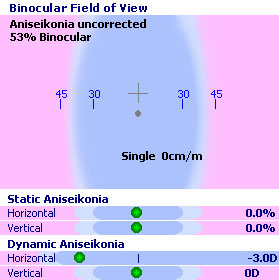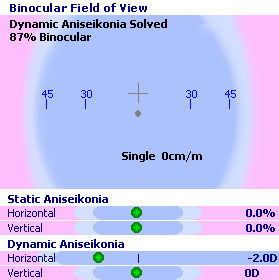Moderate myopia contact lens wearer with trouble adapting to glasses. Age 25.
| Sphere | Cylinder | Axis | Add | PD | |
| OD | -5.00 | 32 | |||
| OS | -5.00 | 32 |
| BU | BD | BI | BO | ||
| 2 | 2 | 4 | 12 |
| Eye | DBL | Wrap | Vertex | Height | |
| 54 | 16 | 7 | 12 | 21 |
 Minus power glasses lenses force the eyes to diverge in lateral gaze. This compounds the demand on base in prism. With her prescription, this patient always had trouble diverging her eyes in lateral gaze and, as a result, a conventional lens design restricted her binocular field of vision. Dynamic aniseikonia is induced due to the prismatic effect of a lens rotation about a vertical axis. This case looks unremarkable, but the binocular field of view is limited even with this relatively low face form angle.
Minus power glasses lenses force the eyes to diverge in lateral gaze. This compounds the demand on base in prism. With her prescription, this patient always had trouble diverging her eyes in lateral gaze and, as a result, a conventional lens design restricted her binocular field of vision. Dynamic aniseikonia is induced due to the prismatic effect of a lens rotation about a vertical axis. This case looks unremarkable, but the binocular field of view is limited even with this relatively low face form angle.
This case demonstrates how dramatically negative fusional vergence facility can affect the adaptation to a myopic spectacle correction. This case looks unremarkable, but the binocular lateral field of view is limited even with this relatively low face form angle (7°).



Note how SHAW lens optimization increases the binocular field. This technology is highly effective with contact lens patients and helps them rapidly adapt to their eyeglasses and avoid the diplopia that commonly happens when they first put on their glasses.